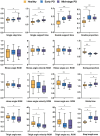A novel multi-level 3D pose estimation framework for gait detection of Parkinson's disease using monocular video
- PMID: 39764149
- PMCID: PMC11700975
- DOI: 10.3389/fbioe.2024.1520831
A novel multi-level 3D pose estimation framework for gait detection of Parkinson's disease using monocular video
Abstract
Introduction: Parkinson's disease (PD) is characterized by muscle stiffness, bradykinesia, and balance disorders, significantly impairing the quality of life for affected patients. While motion pose estimation and gait analysis can aid in early diagnosis and timely intervention, clinical practice currently lacks objective and accurate tools for gait analysis.
Methods: This study proposes a multi-level 3D pose estimation framework for PD patients, integrating monocular video with Transformer and Graph Convolutional Network (GCN) techniques. Gait temporal and spatial parameters were extracted and verified for 59 healthy elderly and PD patients, and an early prediction model for PD patients was established.
Results: The repeatability of the gait parameters showed strong consistency, with most of the estimated parameters yielding an Intraclass Correlation Coefficient (ICC) greater than 0.70. Furthermore, these parameters exhibited a high correlation with VICON and ATMI results (r > 0.80). The classification model based on the extracted parameter features, using a Random Forest (RF) classifier, achieved an accuracy of 93.3%.
Conclusion: The proposed 3D pose estimation method demonstrates high reliability and effectiveness in providing accurate 3D human pose parameters, with strong potential for early prediction of PD.
Significance: This markerless method offers significant advantages in terms of low cost, portability, and ease of use, positioning it as a promising tool for monitoring and screening PD patients in clinical settings.
Keywords: 3D pose estimation; Parkinson’s disease (PD); gait detection; graph convolutional network (GCN); monocular video.
Copyright © 2024 He, You, Zhou, Chen, Diao, Jiang, Ning, Zhao and Liu.
Conflict of interest statement
The authors declare that the research was conducted in the absence of any commercial or financial relationships that could be construed as a potential conflict of interest.
Figures






Similar articles
-
Effective evaluation of HGcnMLP method for markerless 3D pose estimation of musculoskeletal diseases patients based on smartphone monocular video.Front Bioeng Biotechnol. 2024 Jan 9;11:1335251. doi: 10.3389/fbioe.2023.1335251. eCollection 2023. Front Bioeng Biotechnol. 2024. PMID: 38264579 Free PMC article.
-
A multimodal Parkinson quantification by fusing eye and gait motion patterns, using covariance descriptors, from non-invasive computer vision.Comput Methods Programs Biomed. 2022 Mar;215:106607. doi: 10.1016/j.cmpb.2021.106607. Epub 2021 Dec 30. Comput Methods Programs Biomed. 2022. PMID: 34998167 Review.
-
Early detection of Parkinson's disease using a multi area graph convolutional network.Sci Rep. 2025 Feb 14;15(1):5561. doi: 10.1038/s41598-024-82027-0. Sci Rep. 2025. PMID: 39952991 Free PMC article.
-
Concurrent Validity of Zeno Instrumented Walkway and Video-Based Gait Features in Adults With Parkinson's Disease.IEEE J Transl Eng Health Med. 2022 Jun 3;10:2100511. doi: 10.1109/JTEHM.2022.3180231. eCollection 2022. IEEE J Transl Eng Health Med. 2022. PMID: 35795874 Free PMC article.
-
The Role of Deep Learning and Gait Analysis in Parkinson's Disease: A Systematic Review.Sensors (Basel). 2024 Sep 13;24(18):5957. doi: 10.3390/s24185957. Sensors (Basel). 2024. PMID: 39338702 Free PMC article.
References
-
- Benjaminse A., Bolt R., Gokeler A., Otten B. (2020). A validity study comparing xsens with vicon. Available at: https://www.semanticscholar.org/paper/A-VALIDITY-STUDY-COMPARING-XSENS-W... (Accessed October 24, 2024).
LinkOut - more resources
Full Text Sources

